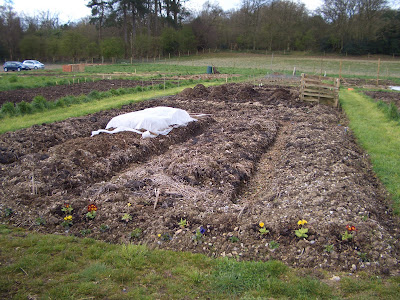 So many people are up at the allotment whenever the weather allows in this mild and wet autumn, digging and digging and no doubt suffering many bad backs along the way. I never have to seriously dig my plot! And neither do any plotters who have made raised beds for all their cultivation needs.
So many people are up at the allotment whenever the weather allows in this mild and wet autumn, digging and digging and no doubt suffering many bad backs along the way. I never have to seriously dig my plot! And neither do any plotters who have made raised beds for all their cultivation needs.It seems to have taken the gardening fraternity a hugely long time to realise that the main reason for digging is to break up the soil compacted by continually walking over it in the first place. Classic books of my childhood such as Middleton's Gardening Guide (2/6d in old money or 12.5 pence in new - paid for out of hard earned pocket money!!) and Arthur Hellyer's The Illustrated Gardening Encyclopedia have no mention whatsoever of the technique of raised beds and both devote quite some space to telling the reader exactly how to dig, and double dig!
 OK when we took over the plots originally they did need digging - to clear the area of the rough grass that was the initial field. I have described before in this blog how I laid out my plot in the first place, and this includes several raised beds - simply cut out of the plot by creating sunken paths in between. No need to buy wooden boarding at all. The beds are of a width that enables me to work them by reaching across from each side, never therefore having to tread on the soil itself. And along the paths I spread wood chippings that I have made myself from all my wood prunings saved throughout the year (having inherited a very useful chipping machine). This means I can walk along the paths and reach the beds in all weathers when other plotters cannot get on to their allotment for the mud! And weeds on the pathways are totally suppressed.
OK when we took over the plots originally they did need digging - to clear the area of the rough grass that was the initial field. I have described before in this blog how I laid out my plot in the first place, and this includes several raised beds - simply cut out of the plot by creating sunken paths in between. No need to buy wooden boarding at all. The beds are of a width that enables me to work them by reaching across from each side, never therefore having to tread on the soil itself. And along the paths I spread wood chippings that I have made myself from all my wood prunings saved throughout the year (having inherited a very useful chipping machine). This means I can walk along the paths and reach the beds in all weathers when other plotters cannot get on to their allotment for the mud! And weeds on the pathways are totally suppressed.And this week I have been up there smartening the paths again, spreading more chippings and generally tidying up. Adding my own compost, fresh manure or rotted manure on top of the soil according to the planned use of the area next year helps to maintain the height of the raised beds above the paths and only needs a light forking in when I am ready to sew or plant or whatever. And harvesting roots etc loosens and works the soil with minimum effort. So - NO DIGGING!















































